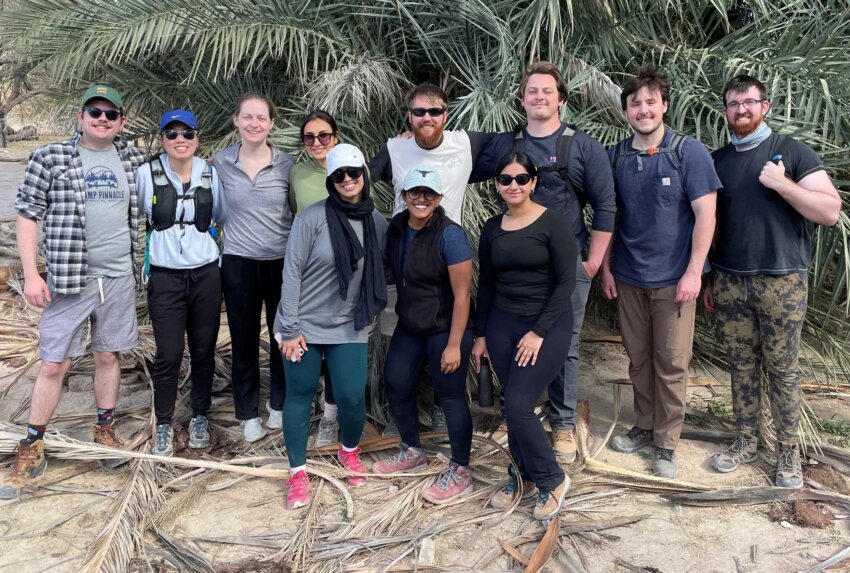There’s never a good place to have a heart attack, but some places are worse than others.
Clutching my chest and sprawled on the Ernst Ridge Trail in Big Bend National Park, high up in a corner of this most vast and remote of Texas parks, I was at least 30 minutes from an ambulance, plus the time to get down. Once down, I was still about two hours from the nearest emergency room, and five hours from the closest trauma center. Helicopter? Maybe four hours, if it had a place to land.
Luckily, I was hiking with a group of fourth-year students and faculty from the Joe R. and Teresa Lozano Long School of Medicine at The University of Texas Health Science Center at San Antonio. Even luckier, I was acting — playing a heart attack victim in one of seven wilderness emergency scenarios staged by students and faculty of what is possibly the most in-demand elective course at the medical school, judging by how immediately it fills and the waiting list.
The four-week class goes by EMED 4007, Wilderness and Survival Medicine, and includes a four-day trip to Big Bend where students practice their emergency medicine skills in an austere environment.
Or, “like ER without the resources,” said Bill Jones, MD, clinical assistant professor of emergency medicine, director of the school’s Wilderness and Survival Medicine Fellowship and a former fellow himself.
Jones was one of 15 faculty and other physicians who joined a total of 44 students rotating in three groups throughout the 10 days of Feb. 10–19. They all met at a group campsite at Rio Grande Village in the southeast corner of the park, about 50 yards from the Rio Grande river.
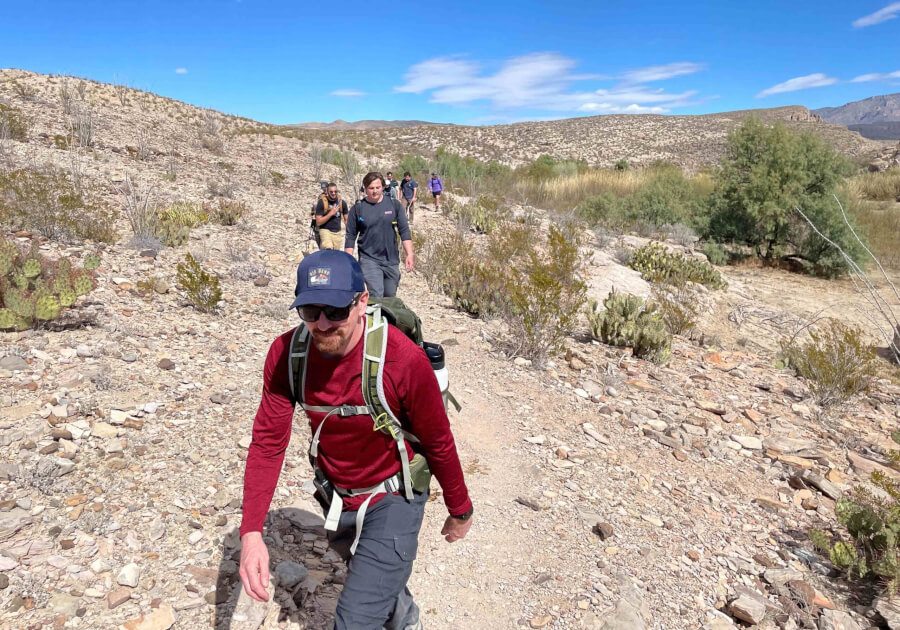
They spent the first full day along the river and on a three-mile hike (six miles round trip) on the rocky and moderately strenuous Ernst Ridge Trail from the campground to Hot Springs, an outdoor tub fed by naturally warm spring water, practicing emergency scenarios along the way.
The next very early morning, everyone rose in pitch darkness at 2:15 and took to the Chisos Mountains in the center of the park, arriving around 3:30 for a challenging 12-mile round-trip hike to the South Rim, the park’s marquee hike. The hike is timed to arrive at the 2,000-foot-high rim by sunrise, affording gorgeous views of the desert below. The truly adventurous among the group added a three-mile round-trip excursion to Emory Peak, the highest point in the park, at an elevation of 7,825 feet.
The students said they weren’t expecting this when they applied for medical school.
“I had no idea that a course like this existed, but I’m really glad it does,” said Natasha Paul of Austin, who jumped at the chance even though she will specialize in obstetrics and gynecology.
“So much of what we do is in the hospital facility where we have all the resources that we need,” she said. “What do you do without an ER or an operating room right in front of you? And so, I liked that this class gave you the opportunity to learn what medicine might be like without those resources.”
The most practical course some may ever take
The course dates to 2020 when its director, Steven Moore, MD, clinical associate professor of emergency medicine, started off wanting 20 students, but took 26. Next time, he capped it at 35. This year, 63 students signed up the moment registration opened. Moore arbitrarily capped registration at 50, eventually settling at 44 students.
“It’s one of the more popular courses in the school. They love it,” Moore said. “The feedback we get every year is: ‘It’s the best course I’ve ever taken.’ A few of them: ‘The best time of my life.’ A lot of them: ‘The most useful course I’ve taken.’ We’re pretty proud of it.”
Emergency medicine is a required clerkship for a third-year medical student at the school, he said, so students need to complete that before taking this course.
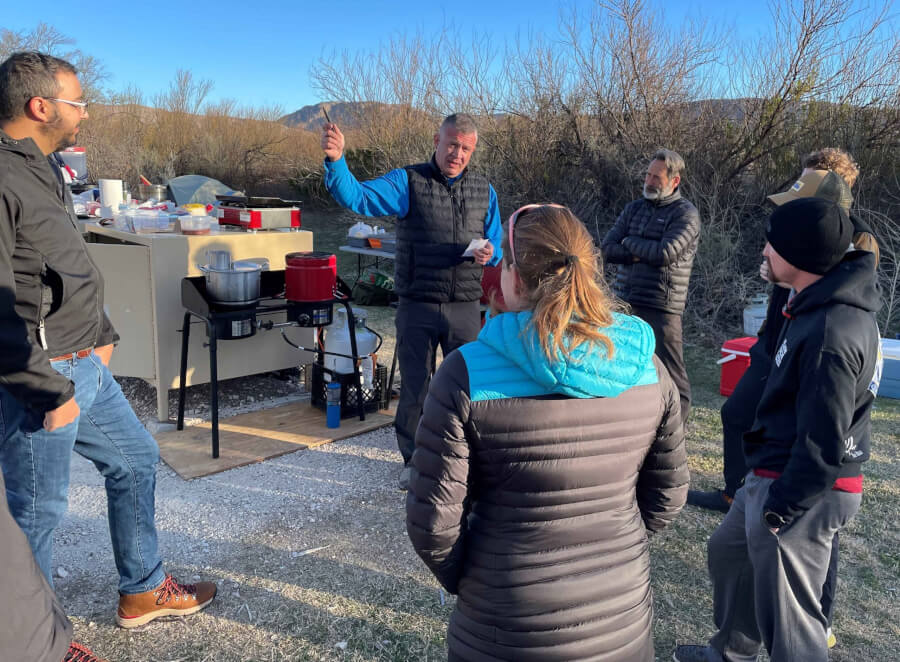
While many of the students will specialize in emergency medicine, a growing number, like Paul, are pursuing other specialties — from internal and family medicine to surgery, anesthesiology, ophthalmology and radiation oncology.
And yet, they see the merit in applying what they’ve learned the last four years of medical school in this most basic, sparse and quick-on-your-feet environment.
“This rounds me out,” said Kyle Zatyko of Dallas, who hopes to practice in Austin or San Antonio. “I feel like physicians need to know how to handle an emergency wherever we come across it.”
The idea for the pre-dawn hike to the South Rim came in the first year when Moore told the class he regretted they wouldn’t get to take in the sunrise there — that to do so, they’d need to wake up around 2 a.m. “Why can’t we do that?” one student, Mitchel Faulkner, asked. He huddled with the other students, then turned back to Moore, saying, “We’ll do it.”
Today, Faulkner, who would go on to serve his residency at UT Health San Antonio, is doing a wilderness medicine fellowship at the University of Utah. Another student became involved in a similar elective at the University of Michigan. Jones, the current fellowship director, took part in the course as a resident, and Austin Gay, MD, a third-year resident also helping on this trip, took the course as a student.
Moore notes that Robert Quinn, MD, professor and chair of the Department of Orthopaedics at UT Health San Antonio, and an accomplished mountaineer, is a past president of the Wilderness Medical Society and a fellow of the Academy of Wilderness Medicine. “So, it attracts everyone,” Moore said. “And everyone kind of finds their niche within the specialty.”
Learning to take charge and group problem solve
For the scenarios, Moore had this bit of instruction to the group: “Just immerse yourself in the scenario and let your common-sense brain kind of kick in,” he said. “Think about the weather, think about what’s comfortable for you, think about how you would be if you were this patient. Don’t worry so much about getting the right answer. Just think about the problem and work through it.”
The first scenario simulated patients with fairly routine abdominal pain, with one needing to be picked up and carried. The next one, though, jolted the students soon enough: a catastrophic boat accident on the river with mass casualties.
The depicted casualties included a drowning cardiac arrest, a pediatric hypothermia/respiratory arrest, an open/compound femur fracture with femoral artery laceration, an unconscious head injury, a shoulder dislocation and a missing uninjured infant requiring a hasty search — plus a hysterical parent distracting the medical providers.
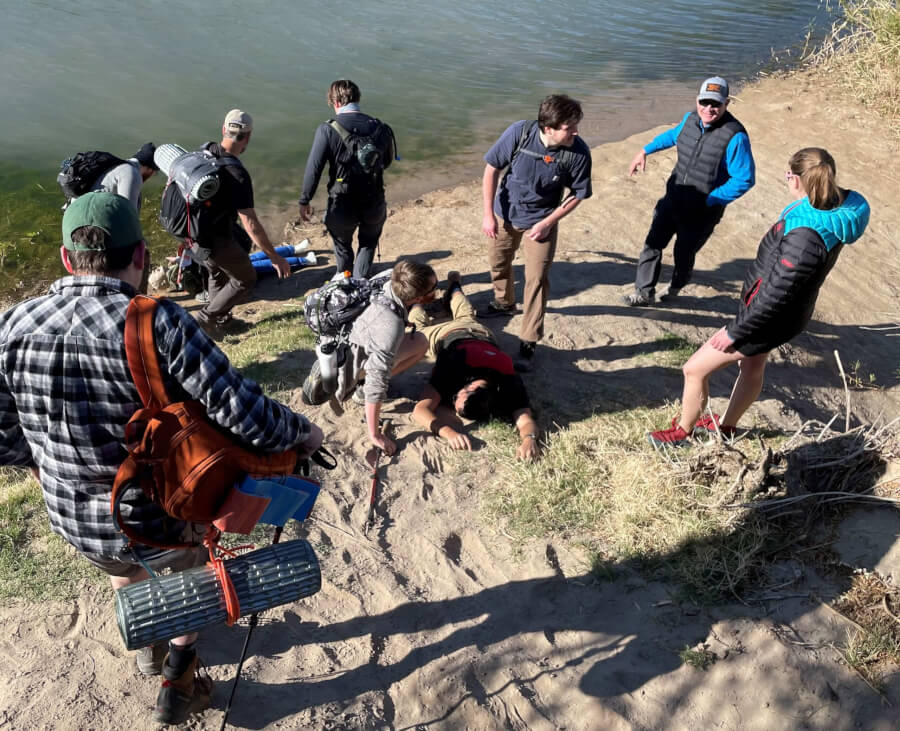
“Where’s my baby? Where’s my baby?” Jones, as the hysterical parent, shrieked. Gay simulated the fracture and laceration victim as students carefully applied tourniquets. Jacob Feldman, MD, clinical assistant professor of emergency medicine, playing the unconscious head injury patient, lay motionless on the bank. Other actors portrayed less serious injuries. Dummies were used for the baby and the lone fatality.
Moore and Ryan Bierle, DMSc, PA, clinical assistant professor of both emergency and internal medicine, prompted the students as needed, trying not to direct but rather pushing them to determine treatment, commit to it and go.
“Who’s in charge, here?” Moore asked. “Who’s running this right now? Is somebody in charge here?”
“I’ll be in charge,” replied Nekel Holbrook, a student from Utah who plans to practice family medicine.
Earlier, Holbrook told me that she, herself, got lost in the wilderness one time for three days and two nights and had to be rescued. “And so, this is something that I’m very passionate can happen to anybody, regardless of how much knowledge you have,” she said. “No one is immune.”
The students scrambled from patient to patient, asking questions, doing assessments. When one student suggested a patient needed neurosurgery, Moore reminded, “Right. Which is where? Five hours away. So, we need to be calling.”
A satellite phone appeared. “Oh, we’re actually calling?” a student asked. Moore handed it to Holbrook and instructed her to call, but to say, “Exercise, exercise, exercise” first, indicating a drill. Bierle was at the other end.
Holbrook: “Exercise, exercise, exercise … Call EMS, we have a [triage category] red head injury. We’re working on a rope litter to get him moving out … but we need to call EMS. Exercise, exercise, exercise.”
Response: “Exercise 911, what happened?”
Holbrook: “We had a boat crash by the Rio Grande Village Campground and we have six victims. One [triaged] black. One red, with a head injury unconscious, working on a litter to get him out. Others currently stable.”
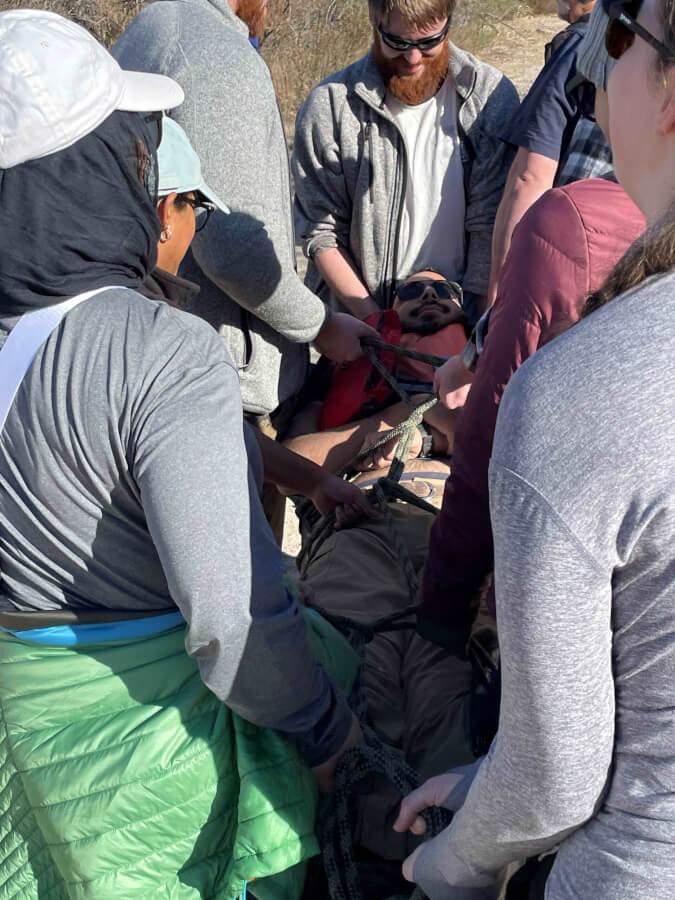
Response: “How many other injuries do we need to be prepared to take care of?”
Holbrook: “We have a compound leg fracture, and some form of shoulder injury. Outside of that, the other two victims seem to be stable without injuries. Maybe distressed, but physically intact.”
Response: “Can you evacuate?”
Holbrook: “Yes, we can evacuate to the parking lot of Group Campground C of Rio Grande Village.”
Response: “911 out. Exercise, exercise, exercise.”
Holbrook: “All right, out. Exercise, exercise, exercise.”
“OK, so you guys heard, we’re going to get him out,” Holbrook told the others. They set to work building a rope litter, essentially a stretcher, carefully placing Feldman on a tarp and tying it over with ropes and large carabiners. Positioned on either side, they lifted and carried him up the boat ramp to the parking lot.
Afterward, they all gathered in a circle to discuss what went right and what went wrong. Should they have triaged Feldman red earlier, rather than a less-serious yellow initially? Should they have applied only one tourniquet first, and waited to apply the second as needed? Should they have moved faster, with water rising from the river?
Feldman, for his part, was complimentary. “I thought the communication was really good. You communicated very clearly,” he said, adding, “And not dropping me. I really appreciated that.”
Life-and-death scenarios along the wilderness trail
As we headed up the Ernst Ridge Trail, it was getting closer to my cameo. We separated into two groups of students and faculty. Moore had asked me to go with the first group, but to intentionally fall behind and then collapse near the top of the first big ridge.
I dutifully dropped to a sitting position before lying back, started groaning and breathing irregularly, and complained about chest pain. Immediately, the students descended, asking where it hurt, could I remember where I was, was I hot or cold, was I taking medications, did I have family history of heart trouble, and so on. I held my breath.
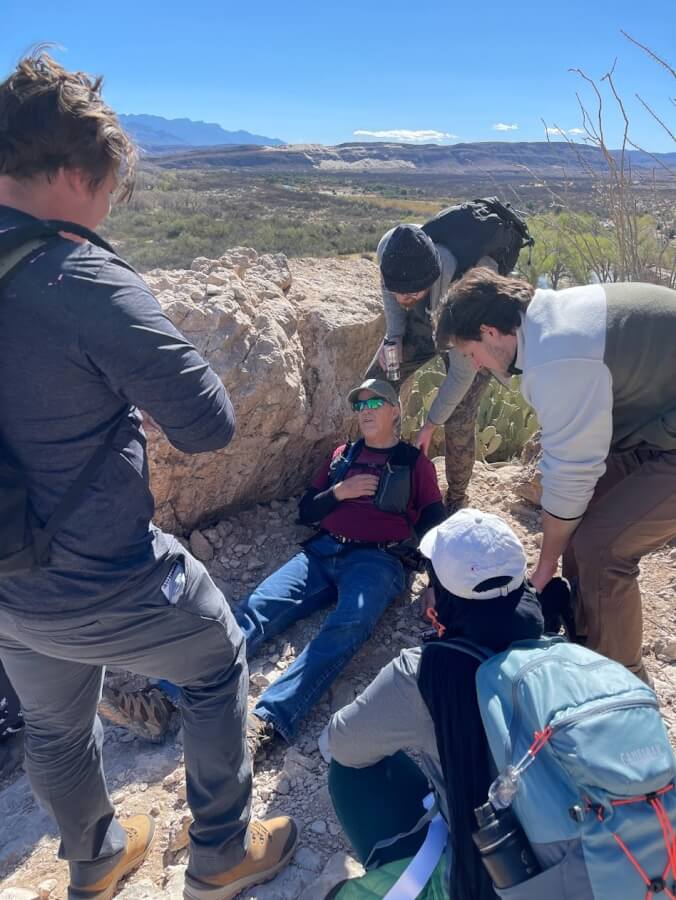
They removed my backpack, did CPR (without the mouth-to-mouth) and pretended to shock me with an Automated External Defibrillator, or AED. Then, they discussed how they were going to get me out. Helicopter? Moore reminded them about the time and trouble that would take.
They would need to carry me, or if I could walk, assist me in walking back down a considerable distance to an ambulance at Rio Grande Village — if they were able to call or radio one to come — and then wait the 30 minutes. There was no cell service.
The first group continued their hike and left me there for the next group, about 15 minutes behind, and I repeated the same act. Same conclusion: They had to get me down.
As I was not a faculty member, but merely an observer, a couple of students later told me they initially thought my act might be real.
Throughout, I kept thinking about things very real. I wasn’t far from where two people, a 14-year-old boy and his stepfather, died last summer, overcome by the heat while hiking. The sheer helplessness they must have felt.
And also last year, on this same class trip, the group passed a Boy Scout troop going the opposite way while hiking. As the last of the class finished the hike, they encountered rangers mobilizing to head back up the trail: One of the Scout leaders had suffered a heart attack. He didn’t survive.
Now, there’s a bright yellow emergency AED box posted on the trail that the troop had hiked.
First assess, then reassess
The other scenarios depicted anaphylaxis from a bee sting; High Altitude Cerebral Edema, known as HACE, and High Altitude Pulmonary Edema, or HAPE; a climbing fall with reported neck and ankle pain; altered mental status with seizure; and a particularly bizarre case of multi-system trauma with gunshot wounds. That one resulted in a femoral artery laceration requiring a tourniquet, in addition to treatment for a “sucking chest wound,” or an open hole to the chest.
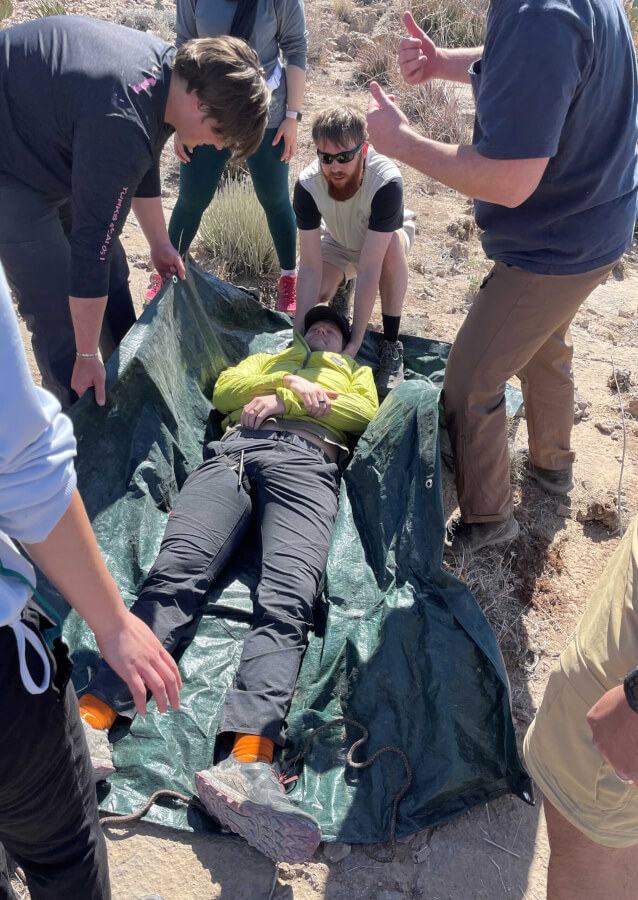
The premise was that the bullets inadvertently came from a hunter’s rifle, as hunting occasionally is used to cull non-native species. Said Stefan Jensen, MD, an emergency attending physician at Baylor Scott & White Medical Center in Austin who took a turn as the victim this time, “The students don’t flex all these muscles within the four walls of your patient room or hospital.”
Student Ethan Deschner of Wimberley, who plans to go into internal medicine, was the leader flexing on this one. He came away with an appreciation of the assessment process the students went through to arrive at consensus.
“I was saying let’s set up the litter, let’s get the tourniquet on, let’s get the two patches for his lung wound and let’s move the patient,” Deschner said. “But one of the persons who was managing the leg wound was like, hold on, before we move, let’s assess. That was a really good suggestion. And we paused, reassessed, [determined] it was fine. We put him on [the litter] and as soon as we moved him, we reassessed again, because when you move a patient, things can happen,” said Deschner.
“So, it was a dynamic in which someone was leading, but also everyone’s opinion is valid,” he said. “And so, it was a good way to practice that, I think.”
Paul, the OB-GYN student from Austin, recalled a brief moment from one of the scenarios when all of the students in her group seemed stumped.
“We all kind of looked at each other in silence where we thought, ‘This is hard. This guy, if he were really out there, he was dying,’” she said. “In moments of emotional turmoil, you really have to be able to dive deep into your training and find [the resolve]. So, I think that silent moment was kind of a wake-up call for me.”
Finding courage, building trust in your team
The students also drew lessons and value from the South Rim hike the next morning, even though it largely was meant as a recreational reward.
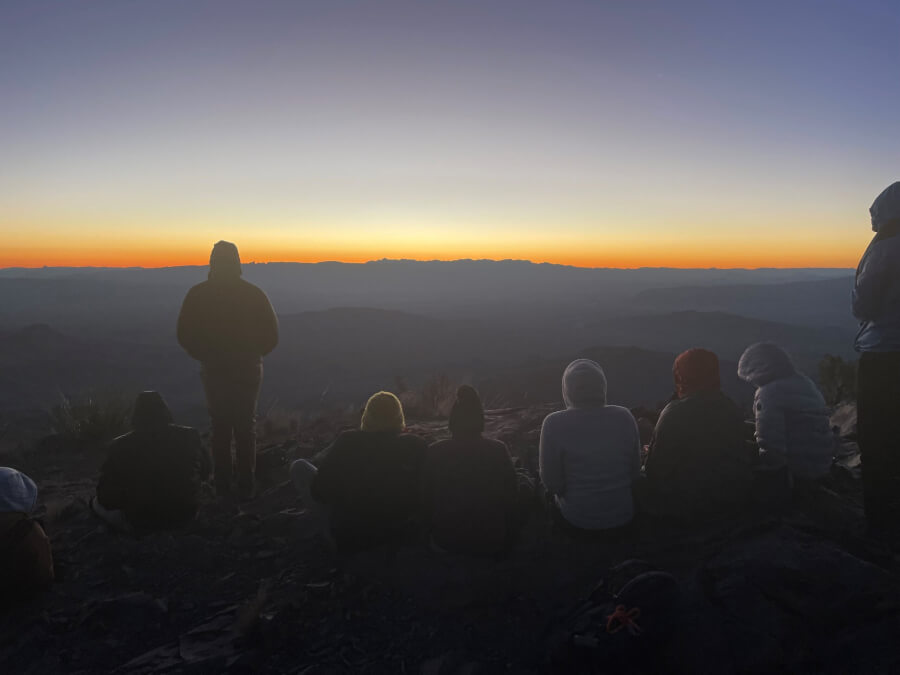
By the time they reached the rim and took in a glorious sunrise, temperatures were in the 20s with a wind chill in the teens. Aside from the cold and the difficulty, Deschner said, “It really makes you think that if you were just doing that hike for fun with people and if somebody broke their ankle, how are you going to manage to get them down? It makes you realize the stakes.”
Paul said she was surprised at how fast she made it to the rim. She called the four days “1,000% worth it.” This, from someone who had never camped before, telling everyone she was a “glamper,” one who prefers lodging in comfort. “One thing that medical school taught me is that you always rise to the occasion,” she said.
“Also, it falls right along our match time for residency, so it’s really a nice way to decompress and get to know our classmates better,” said Jessica Giacoman of Dallas, who plans to specialize in emergency medicine. “And just having fun, not being in a classroom.”
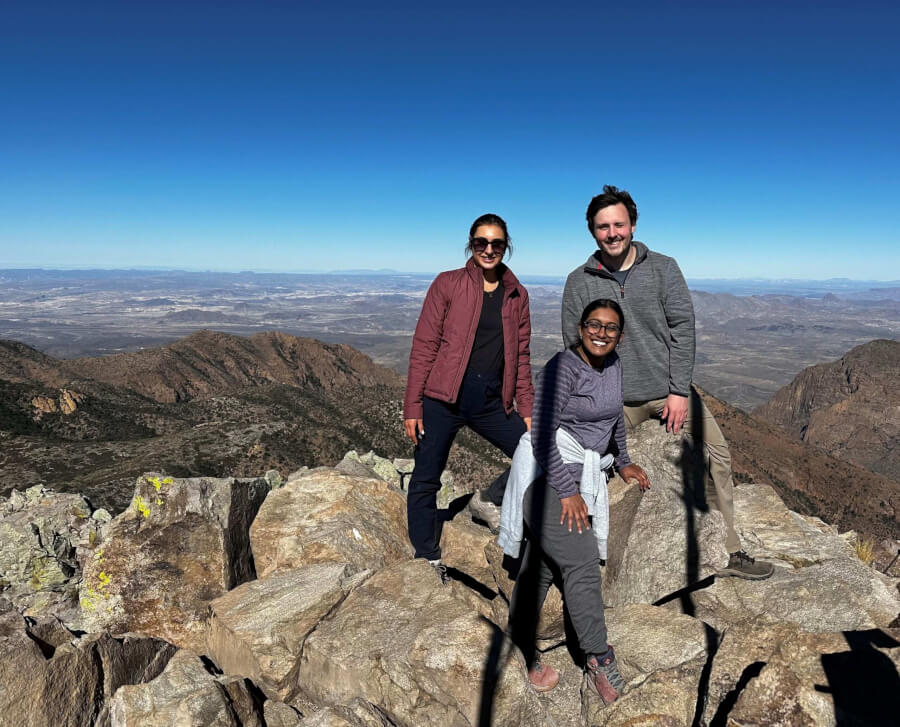
Paul, Giacoman and Alex Henze, an internal medicine student from Magnolia and with family in Uvalde, were the only students in the first rotation who opted for the extra hike to Emory Peak and made it to the top. The trail itself is strenuous and mostly uphill, with a short rock climb at the end that some find daunting.
Those who make it get a sweeping 360-degree view of the park at its highest point. As the three got closer to the top, Paul started having second thoughts.
But just as the students had worked together to get through each scenario the day before, she said the same thing happened on the peak.
“I feel like I was maybe the instigator to go up, but I was probably the one who was really panicking a little bit on the climb, and Jess and Alex really got me through it,” Paul said.
“I felt like I really trusted them. I was sitting there telling them, ‘Hey guys, I’m really scared. You’re going to have to talk me through this.’” And they did, said Paul.
“I think in medicine there’s always give and take, and when you have a couple of minds working together, you’re always a lot stronger.”


